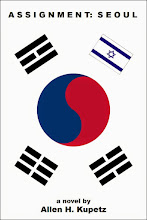
Black is back.
Perhaps to match the gloomy economic outlook for the rest of the year, black dominated the catwalks at Seoul Fashion Week, which ended Thursday.
Despite the depressing lack of color, Korean designers still managed to introduce new styles and trends in their fall and winter collections.
Star power certainly helped attract crowds to the Seoul Trade Exhibition Center (SETEC), Daechi-dong, southern Seoul. "Boys Over Flowers" actors Kim Hyun-joong and Kim Jun, SS501 member Kim Hyung-jun and actress Kim Min-sun turned models on the runway.
Korean celebrities such as Yoon Eun-hye, Hwang-bo, Hwanhee, Ha Jung-woo, Kim Seung-soo and Girls Generation member Yoona attended some of the high-profile fashion shows over the eight-day event.
Tickets to the fashion shows sold like hotcakes. Organizers even had to turn away people at some shows because the halls were already packed.
Men's Wear
As usual, the men's wear collections kicked off fashion week. Most of the designers were particularly inspired by the military look, while other designers sought to reinterpret the classic suit.
Han Sung-hyuk, creative director for Cheil Industries' Mvio brand, presented a collection inspired by the fictional British detective Sherlock Holmes. Camel-colored jackets and coats were accented with herringbone and argyle prints, while pants were cropped at the ankle.
Ultra-stylish gangsters paraded down the runway for Kang Dong-jun's collection, inspired by the crime movie "Carlito's Way." Models were smoking, literally, as they puffed on cigars while wearing vests, boxy jackets, fedora hats, leather jackets and loose trousers.
Trench coats were all over the men's wear collections. Park Sung-chul showed double-breasted trench coats and cape jackets in khaki. Juun J. transformed the trench coat into military-style ponchos and rider jackets.
Classic suits were given a fresh spin, as seen with the slimmer silhouettes, structured jackets and fitted vests by Park Herin, and asymmetrical double lapels and relaxed silhouettes by Chang Kwang-hyo.
Elements of hip-hop, sports and street style came together at Kim Gyu-sik's "staring by Taste Maximum." In a surprise twist, Kim used androgynous-looking females to model well-cut denim jeans, tough-looking motorcycle jackets and layers of thick scarves.
Women's Collections
Black remained the color of choice for most designers, but thankfully, black was complemented with shades of red, yellow, green, blue and white.
Most designers seemed to forego romantic and overtly luxurious designs, in favor of men's wear-inspired jackets and comfortable coats.
Comfortable style is what Imseonoc presented with her collection of flirty dresses, coats without closures and elastic waist pants. Voluminous silhouettes and toned down colors also characterized Song Jain's collection.
The military wear trend in the men's wear collection seemed to have crossed over to women's wear collections. Moon Young-hee tried to inject femininity in jackets and coats, resulting in pretty peplum jackets and stylish coats, made of silk, satin and wool.
Rising designer Ha Sang-beg presented futuristic military uniform-style jackets, coats and dresses with exaggerated details like pockets and epaulets. Yang Hee-min delivered a "decadent chic" collection, which included halter-neck jumpsuits, belted slim coats and jodhpurs.
Sweet and romantic looks were not totally gone for the fall/winter collections. Cho Sung-kyong's Latulle line did not disappoint with retro-romantic dresses, floral prints, cardigans and smoking jackets in luxurious silk, wool and fur.
Doii Lee's collection featured shiny metallic leggings, modern kimono-sleeve dresses and dazzling prints inspired by the Japanese fairy tale "Butterfly Girl."
For his "Troa by Han Song" collection, Han Song introduced mini dresses with floral prints, multi-colored rosette details and asymmetrical padded jackets and tight "leg-hugging pants."
While Son Jung-wan used mainly black and dark gray for her elegant and feminine collection, there were bursts of yellow, gold and blue to brighten it up. Models wore plush fur coats, vests and capes, as well as pleated dresses on the catwalk.
Fashion week would not be complete without shows featuring hanbok or Korean traditional dress. Top designer Lee Young-hee never fails to amaze everyone with her innovative hanbok designs. This season, she impressed with sculptural hanbok skirts, pleated dresses and skirts.
Hwang Jae-bock and Bec Jie introduced ultra-feminine evening dresses and wedding gowns that will be the dream of young brides everywhere.
However, not all of the shows were open to the public. Some designers, such as Andy & Debb, Choi Bum-suk and Jung Hee-jung, had small private presentations for professional local and foreign buyers.
http://www.koreatimes.co.kr/www/news/art/2009/07/199_42589.html
◦










